Analyzing the Diathesis-Stress Model in the Context of Social Work
VerifiedAdded on 2020/01/16
|8
|2216
|294
Essay
AI Summary
This essay examines the Diathesis-Stress Model, a psychological theory explaining behavior through the interaction of predispositional vulnerability (diathesis) and stressors. It explores how genetic and environmental factors, along with life experiences, contribute to psychological disorders like anxiety, depression, and schizophrenia. The model is crucial for understanding the relationship between nature and nurture, and for identifying individuals at risk of developing disorders. The essay highlights the model's significance in analyzing the impact of stressors and its relevance to social work practice, particularly in understanding and addressing mental health issues. It discusses the role of clinical psychologists and the importance of considering cultural, ethical, and religious differences in social work. References to key research and publications are included to support the arguments presented, emphasizing the model's importance in understanding the interplay of genetic factors, environmental influences, and psychological experiences.
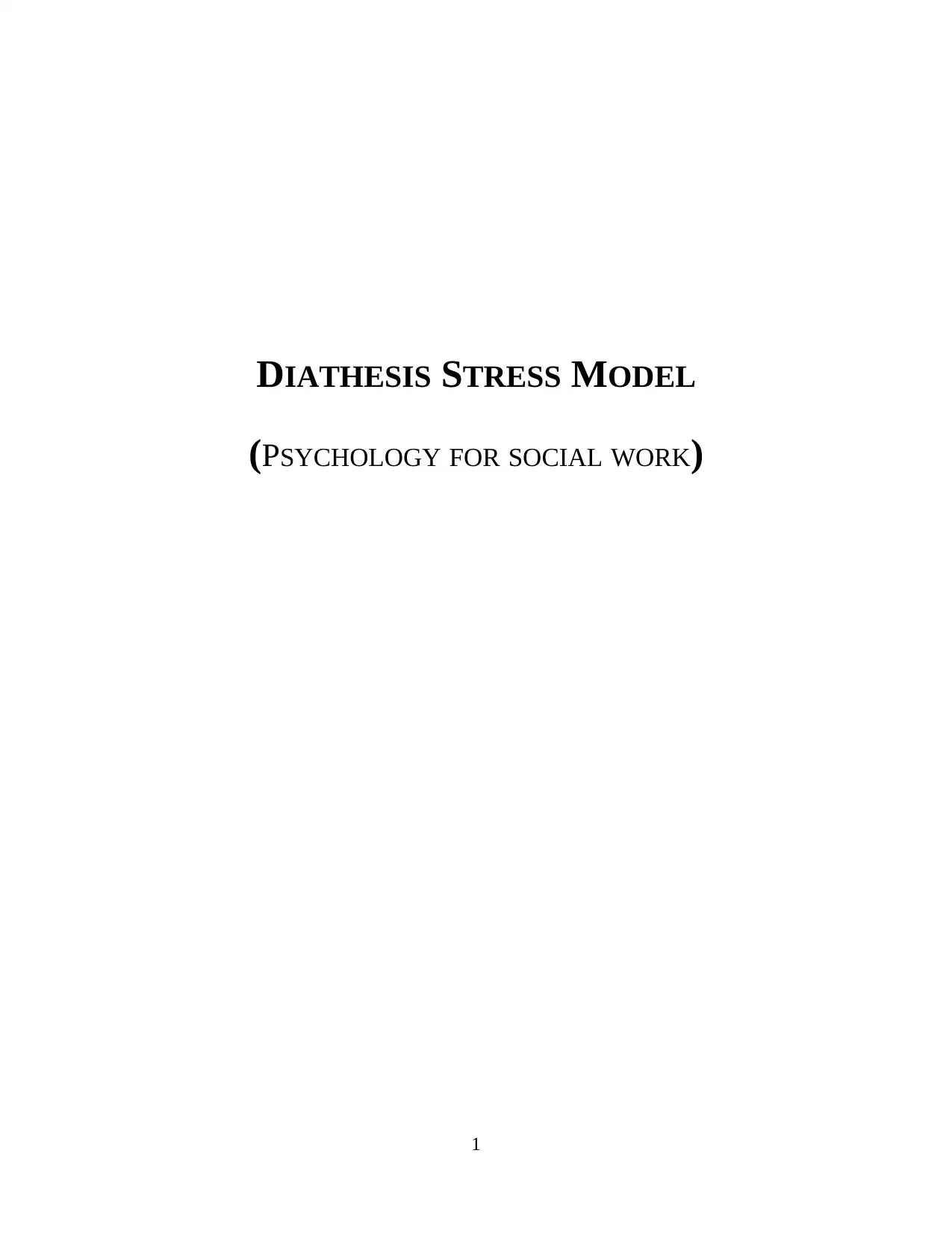
DIATHESIS STRESS MODEL
(PSYCHOLOGY FOR SOCIAL WORK)
1
(PSYCHOLOGY FOR SOCIAL WORK)
1
Paraphrase This Document
Need a fresh take? Get an instant paraphrase of this document with our AI Paraphraser
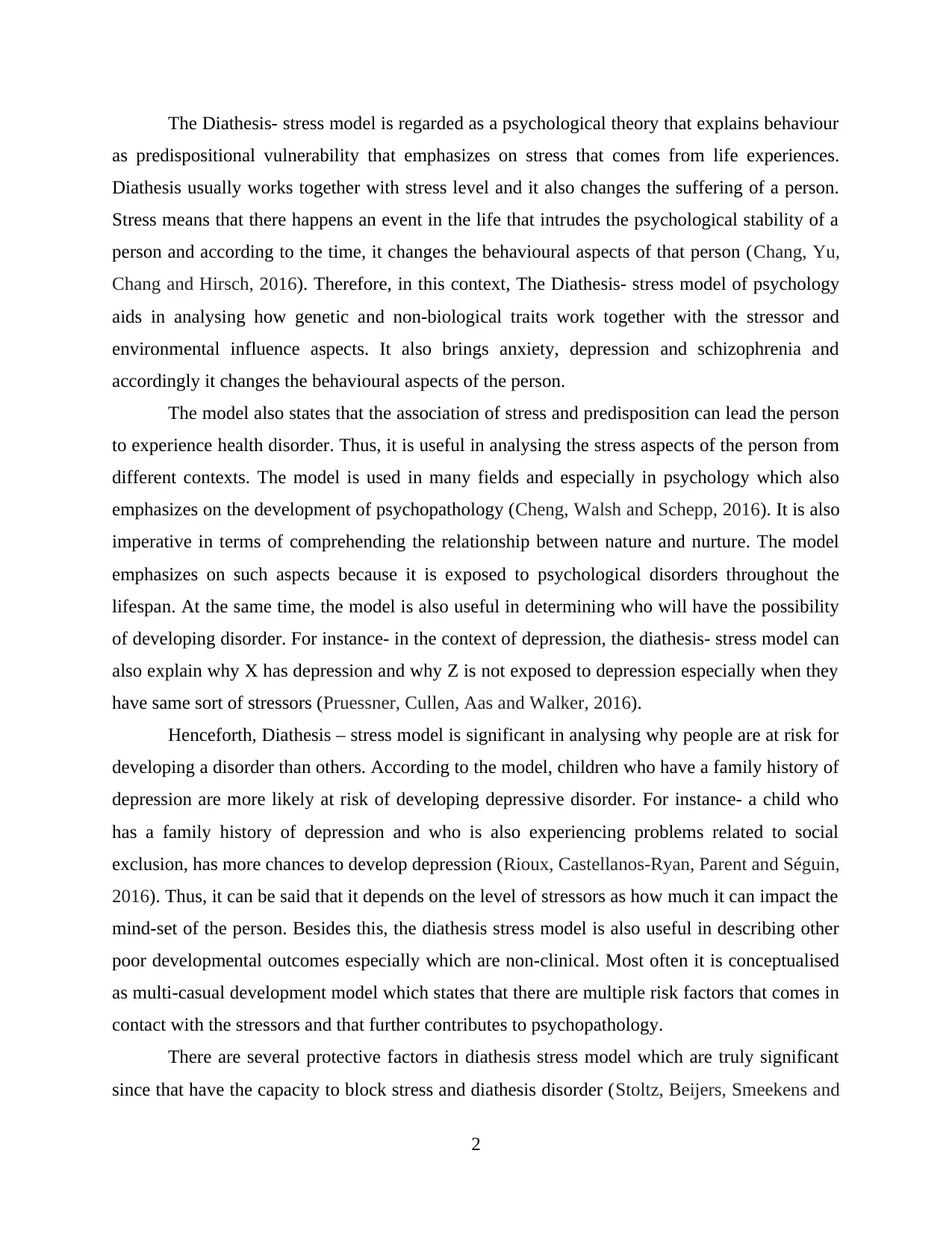
The Diathesis- stress model is regarded as a psychological theory that explains behaviour
as predispositional vulnerability that emphasizes on stress that comes from life experiences.
Diathesis usually works together with stress level and it also changes the suffering of a person.
Stress means that there happens an event in the life that intrudes the psychological stability of a
person and according to the time, it changes the behavioural aspects of that person (Chang, Yu,
Chang and Hirsch, 2016). Therefore, in this context, The Diathesis- stress model of psychology
aids in analysing how genetic and non-biological traits work together with the stressor and
environmental influence aspects. It also brings anxiety, depression and schizophrenia and
accordingly it changes the behavioural aspects of the person.
The model also states that the association of stress and predisposition can lead the person
to experience health disorder. Thus, it is useful in analysing the stress aspects of the person from
different contexts. The model is used in many fields and especially in psychology which also
emphasizes on the development of psychopathology (Cheng, Walsh and Schepp, 2016). It is also
imperative in terms of comprehending the relationship between nature and nurture. The model
emphasizes on such aspects because it is exposed to psychological disorders throughout the
lifespan. At the same time, the model is also useful in determining who will have the possibility
of developing disorder. For instance- in the context of depression, the diathesis- stress model can
also explain why X has depression and why Z is not exposed to depression especially when they
have same sort of stressors (Pruessner, Cullen, Aas and Walker, 2016).
Henceforth, Diathesis – stress model is significant in analysing why people are at risk for
developing a disorder than others. According to the model, children who have a family history of
depression are more likely at risk of developing depressive disorder. For instance- a child who
has a family history of depression and who is also experiencing problems related to social
exclusion, has more chances to develop depression (Rioux, Castellanos-Ryan, Parent and Séguin,
2016). Thus, it can be said that it depends on the level of stressors as how much it can impact the
mind-set of the person. Besides this, the diathesis stress model is also useful in describing other
poor developmental outcomes especially which are non-clinical. Most often it is conceptualised
as multi-casual development model which states that there are multiple risk factors that comes in
contact with the stressors and that further contributes to psychopathology.
There are several protective factors in diathesis stress model which are truly significant
since that have the capacity to block stress and diathesis disorder (Stoltz, Beijers, Smeekens and
2
as predispositional vulnerability that emphasizes on stress that comes from life experiences.
Diathesis usually works together with stress level and it also changes the suffering of a person.
Stress means that there happens an event in the life that intrudes the psychological stability of a
person and according to the time, it changes the behavioural aspects of that person (Chang, Yu,
Chang and Hirsch, 2016). Therefore, in this context, The Diathesis- stress model of psychology
aids in analysing how genetic and non-biological traits work together with the stressor and
environmental influence aspects. It also brings anxiety, depression and schizophrenia and
accordingly it changes the behavioural aspects of the person.
The model also states that the association of stress and predisposition can lead the person
to experience health disorder. Thus, it is useful in analysing the stress aspects of the person from
different contexts. The model is used in many fields and especially in psychology which also
emphasizes on the development of psychopathology (Cheng, Walsh and Schepp, 2016). It is also
imperative in terms of comprehending the relationship between nature and nurture. The model
emphasizes on such aspects because it is exposed to psychological disorders throughout the
lifespan. At the same time, the model is also useful in determining who will have the possibility
of developing disorder. For instance- in the context of depression, the diathesis- stress model can
also explain why X has depression and why Z is not exposed to depression especially when they
have same sort of stressors (Pruessner, Cullen, Aas and Walker, 2016).
Henceforth, Diathesis – stress model is significant in analysing why people are at risk for
developing a disorder than others. According to the model, children who have a family history of
depression are more likely at risk of developing depressive disorder. For instance- a child who
has a family history of depression and who is also experiencing problems related to social
exclusion, has more chances to develop depression (Rioux, Castellanos-Ryan, Parent and Séguin,
2016). Thus, it can be said that it depends on the level of stressors as how much it can impact the
mind-set of the person. Besides this, the diathesis stress model is also useful in describing other
poor developmental outcomes especially which are non-clinical. Most often it is conceptualised
as multi-casual development model which states that there are multiple risk factors that comes in
contact with the stressors and that further contributes to psychopathology.
There are several protective factors in diathesis stress model which are truly significant
since that have the capacity to block stress and diathesis disorder (Stoltz, Beijers, Smeekens and
2
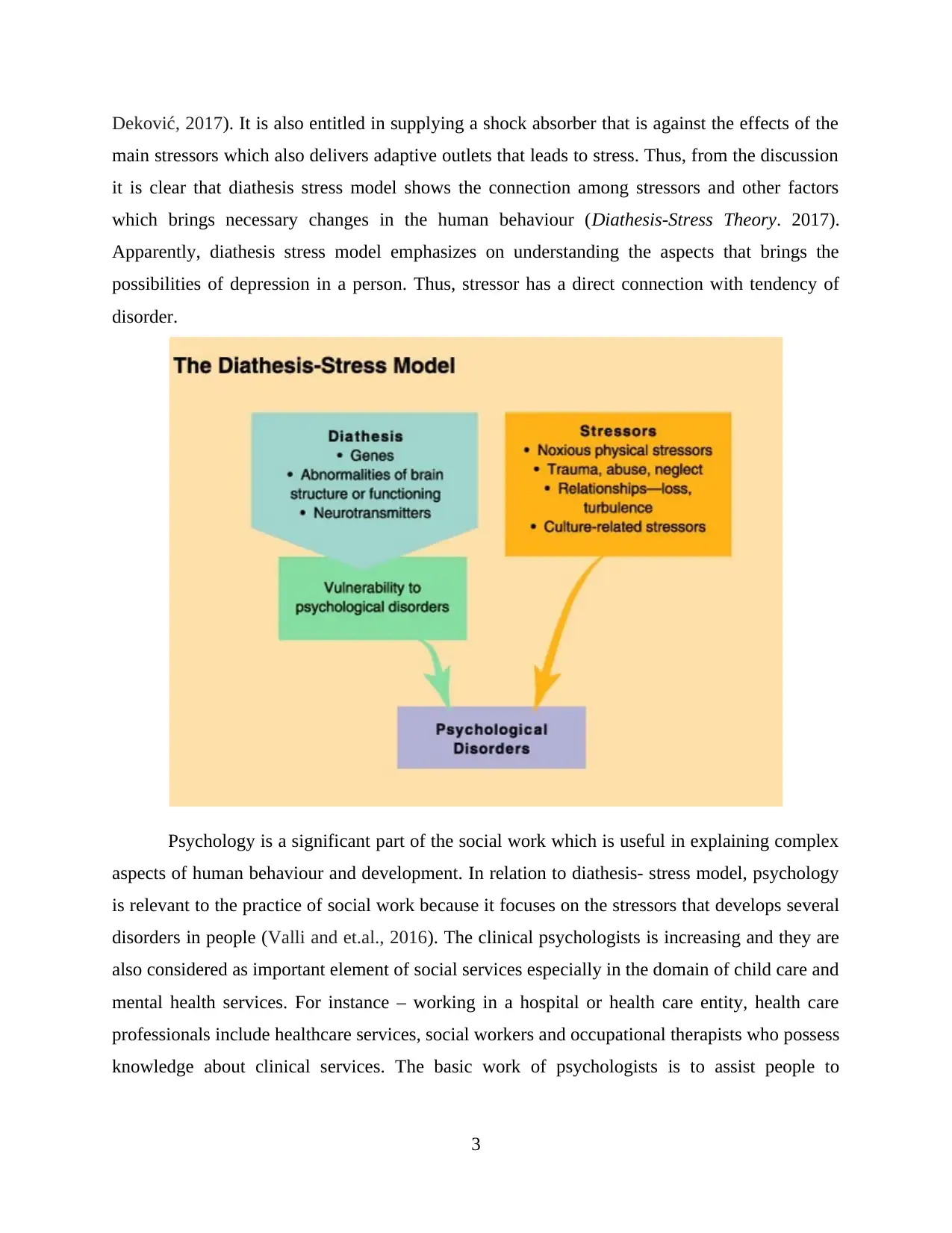
Deković, 2017). It is also entitled in supplying a shock absorber that is against the effects of the
main stressors which also delivers adaptive outlets that leads to stress. Thus, from the discussion
it is clear that diathesis stress model shows the connection among stressors and other factors
which brings necessary changes in the human behaviour (Diathesis-Stress Theory. 2017).
Apparently, diathesis stress model emphasizes on understanding the aspects that brings the
possibilities of depression in a person. Thus, stressor has a direct connection with tendency of
disorder.
Psychology is a significant part of the social work which is useful in explaining complex
aspects of human behaviour and development. In relation to diathesis- stress model, psychology
is relevant to the practice of social work because it focuses on the stressors that develops several
disorders in people (Valli and et.al., 2016). The clinical psychologists is increasing and they are
also considered as important element of social services especially in the domain of child care and
mental health services. For instance – working in a hospital or health care entity, health care
professionals include healthcare services, social workers and occupational therapists who possess
knowledge about clinical services. The basic work of psychologists is to assist people to
3
main stressors which also delivers adaptive outlets that leads to stress. Thus, from the discussion
it is clear that diathesis stress model shows the connection among stressors and other factors
which brings necessary changes in the human behaviour (Diathesis-Stress Theory. 2017).
Apparently, diathesis stress model emphasizes on understanding the aspects that brings the
possibilities of depression in a person. Thus, stressor has a direct connection with tendency of
disorder.
Psychology is a significant part of the social work which is useful in explaining complex
aspects of human behaviour and development. In relation to diathesis- stress model, psychology
is relevant to the practice of social work because it focuses on the stressors that develops several
disorders in people (Valli and et.al., 2016). The clinical psychologists is increasing and they are
also considered as important element of social services especially in the domain of child care and
mental health services. For instance – working in a hospital or health care entity, health care
professionals include healthcare services, social workers and occupational therapists who possess
knowledge about clinical services. The basic work of psychologists is to assist people to
3
⊘ This is a preview!⊘
Do you want full access?
Subscribe today to unlock all pages.

Trusted by 1+ million students worldwide
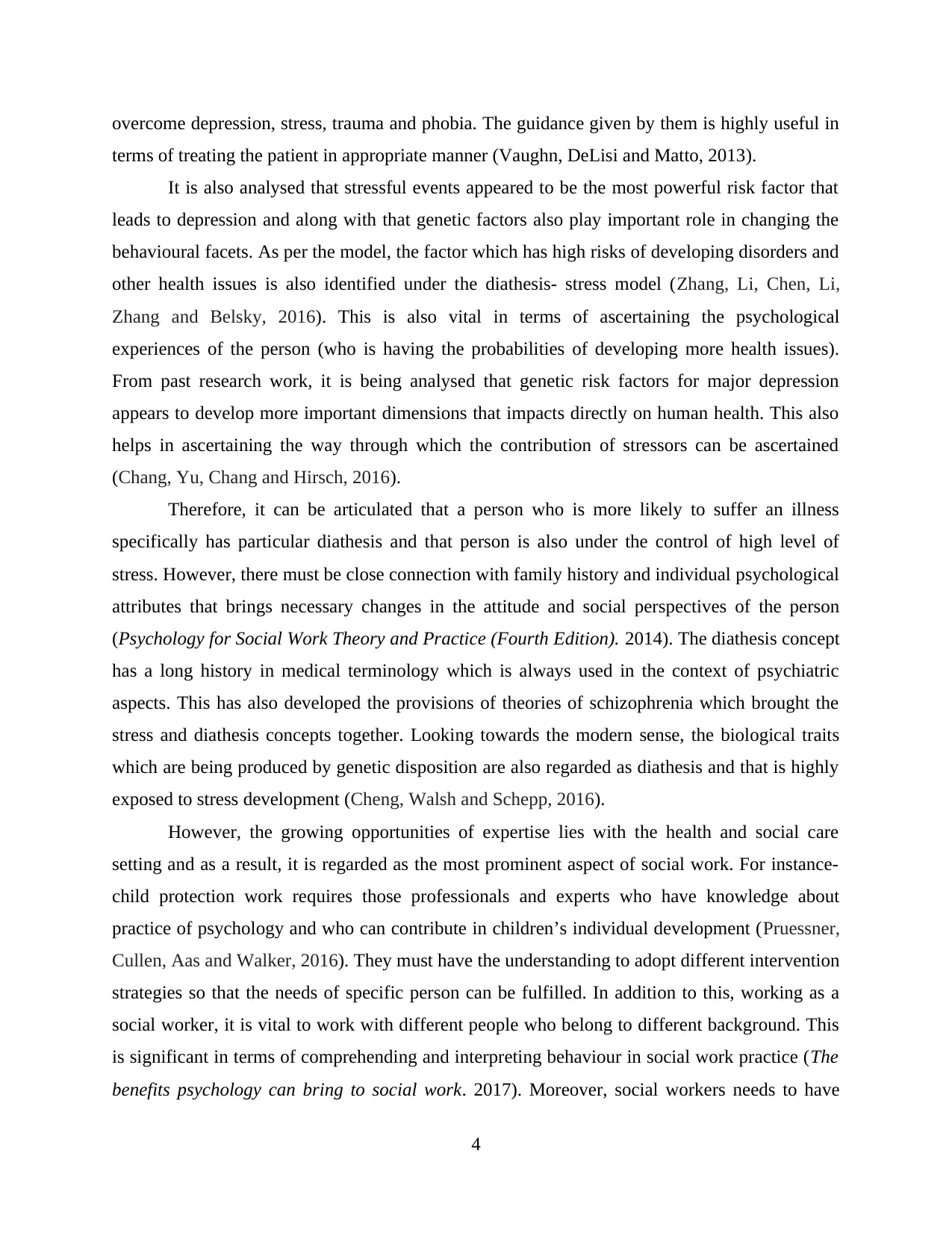
overcome depression, stress, trauma and phobia. The guidance given by them is highly useful in
terms of treating the patient in appropriate manner (Vaughn, DeLisi and Matto, 2013).
It is also analysed that stressful events appeared to be the most powerful risk factor that
leads to depression and along with that genetic factors also play important role in changing the
behavioural facets. As per the model, the factor which has high risks of developing disorders and
other health issues is also identified under the diathesis- stress model (Zhang, Li, Chen, Li,
Zhang and Belsky, 2016). This is also vital in terms of ascertaining the psychological
experiences of the person (who is having the probabilities of developing more health issues).
From past research work, it is being analysed that genetic risk factors for major depression
appears to develop more important dimensions that impacts directly on human health. This also
helps in ascertaining the way through which the contribution of stressors can be ascertained
(Chang, Yu, Chang and Hirsch, 2016).
Therefore, it can be articulated that a person who is more likely to suffer an illness
specifically has particular diathesis and that person is also under the control of high level of
stress. However, there must be close connection with family history and individual psychological
attributes that brings necessary changes in the attitude and social perspectives of the person
(Psychology for Social Work Theory and Practice (Fourth Edition). 2014). The diathesis concept
has a long history in medical terminology which is always used in the context of psychiatric
aspects. This has also developed the provisions of theories of schizophrenia which brought the
stress and diathesis concepts together. Looking towards the modern sense, the biological traits
which are being produced by genetic disposition are also regarded as diathesis and that is highly
exposed to stress development (Cheng, Walsh and Schepp, 2016).
However, the growing opportunities of expertise lies with the health and social care
setting and as a result, it is regarded as the most prominent aspect of social work. For instance-
child protection work requires those professionals and experts who have knowledge about
practice of psychology and who can contribute in children’s individual development (Pruessner,
Cullen, Aas and Walker, 2016). They must have the understanding to adopt different intervention
strategies so that the needs of specific person can be fulfilled. In addition to this, working as a
social worker, it is vital to work with different people who belong to different background. This
is significant in terms of comprehending and interpreting behaviour in social work practice (The
benefits psychology can bring to social work. 2017). Moreover, social workers needs to have
4
terms of treating the patient in appropriate manner (Vaughn, DeLisi and Matto, 2013).
It is also analysed that stressful events appeared to be the most powerful risk factor that
leads to depression and along with that genetic factors also play important role in changing the
behavioural facets. As per the model, the factor which has high risks of developing disorders and
other health issues is also identified under the diathesis- stress model (Zhang, Li, Chen, Li,
Zhang and Belsky, 2016). This is also vital in terms of ascertaining the psychological
experiences of the person (who is having the probabilities of developing more health issues).
From past research work, it is being analysed that genetic risk factors for major depression
appears to develop more important dimensions that impacts directly on human health. This also
helps in ascertaining the way through which the contribution of stressors can be ascertained
(Chang, Yu, Chang and Hirsch, 2016).
Therefore, it can be articulated that a person who is more likely to suffer an illness
specifically has particular diathesis and that person is also under the control of high level of
stress. However, there must be close connection with family history and individual psychological
attributes that brings necessary changes in the attitude and social perspectives of the person
(Psychology for Social Work Theory and Practice (Fourth Edition). 2014). The diathesis concept
has a long history in medical terminology which is always used in the context of psychiatric
aspects. This has also developed the provisions of theories of schizophrenia which brought the
stress and diathesis concepts together. Looking towards the modern sense, the biological traits
which are being produced by genetic disposition are also regarded as diathesis and that is highly
exposed to stress development (Cheng, Walsh and Schepp, 2016).
However, the growing opportunities of expertise lies with the health and social care
setting and as a result, it is regarded as the most prominent aspect of social work. For instance-
child protection work requires those professionals and experts who have knowledge about
practice of psychology and who can contribute in children’s individual development (Pruessner,
Cullen, Aas and Walker, 2016). They must have the understanding to adopt different intervention
strategies so that the needs of specific person can be fulfilled. In addition to this, working as a
social worker, it is vital to work with different people who belong to different background. This
is significant in terms of comprehending and interpreting behaviour in social work practice (The
benefits psychology can bring to social work. 2017). Moreover, social workers needs to have
4
Paraphrase This Document
Need a fresh take? Get an instant paraphrase of this document with our AI Paraphraser
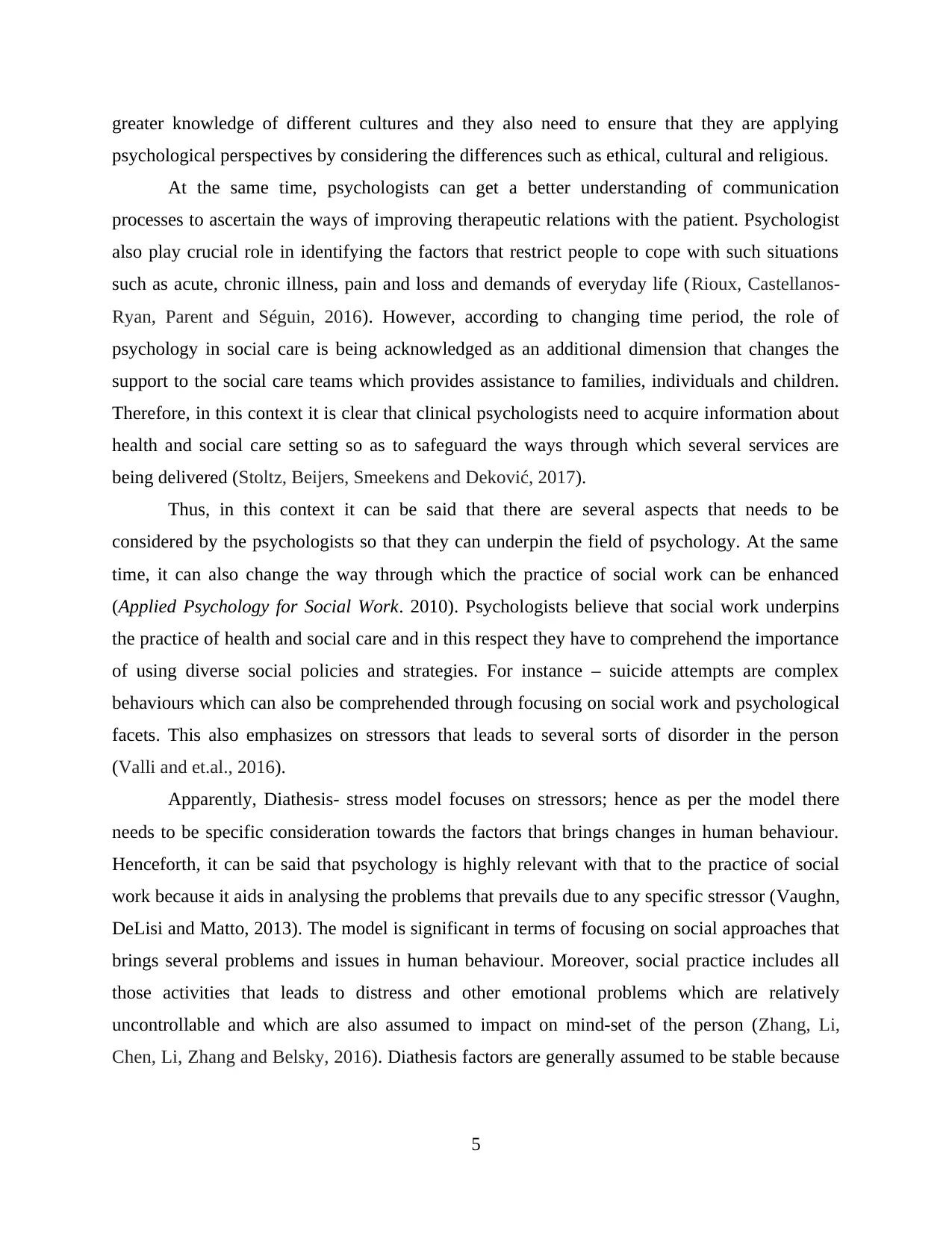
greater knowledge of different cultures and they also need to ensure that they are applying
psychological perspectives by considering the differences such as ethical, cultural and religious.
At the same time, psychologists can get a better understanding of communication
processes to ascertain the ways of improving therapeutic relations with the patient. Psychologist
also play crucial role in identifying the factors that restrict people to cope with such situations
such as acute, chronic illness, pain and loss and demands of everyday life (Rioux, Castellanos-
Ryan, Parent and Séguin, 2016). However, according to changing time period, the role of
psychology in social care is being acknowledged as an additional dimension that changes the
support to the social care teams which provides assistance to families, individuals and children.
Therefore, in this context it is clear that clinical psychologists need to acquire information about
health and social care setting so as to safeguard the ways through which several services are
being delivered (Stoltz, Beijers, Smeekens and Deković, 2017).
Thus, in this context it can be said that there are several aspects that needs to be
considered by the psychologists so that they can underpin the field of psychology. At the same
time, it can also change the way through which the practice of social work can be enhanced
(Applied Psychology for Social Work. 2010). Psychologists believe that social work underpins
the practice of health and social care and in this respect they have to comprehend the importance
of using diverse social policies and strategies. For instance – suicide attempts are complex
behaviours which can also be comprehended through focusing on social work and psychological
facets. This also emphasizes on stressors that leads to several sorts of disorder in the person
(Valli and et.al., 2016).
Apparently, Diathesis- stress model focuses on stressors; hence as per the model there
needs to be specific consideration towards the factors that brings changes in human behaviour.
Henceforth, it can be said that psychology is highly relevant with that to the practice of social
work because it aids in analysing the problems that prevails due to any specific stressor (Vaughn,
DeLisi and Matto, 2013). The model is significant in terms of focusing on social approaches that
brings several problems and issues in human behaviour. Moreover, social practice includes all
those activities that leads to distress and other emotional problems which are relatively
uncontrollable and which are also assumed to impact on mind-set of the person (Zhang, Li,
Chen, Li, Zhang and Belsky, 2016). Diathesis factors are generally assumed to be stable because
5
psychological perspectives by considering the differences such as ethical, cultural and religious.
At the same time, psychologists can get a better understanding of communication
processes to ascertain the ways of improving therapeutic relations with the patient. Psychologist
also play crucial role in identifying the factors that restrict people to cope with such situations
such as acute, chronic illness, pain and loss and demands of everyday life (Rioux, Castellanos-
Ryan, Parent and Séguin, 2016). However, according to changing time period, the role of
psychology in social care is being acknowledged as an additional dimension that changes the
support to the social care teams which provides assistance to families, individuals and children.
Therefore, in this context it is clear that clinical psychologists need to acquire information about
health and social care setting so as to safeguard the ways through which several services are
being delivered (Stoltz, Beijers, Smeekens and Deković, 2017).
Thus, in this context it can be said that there are several aspects that needs to be
considered by the psychologists so that they can underpin the field of psychology. At the same
time, it can also change the way through which the practice of social work can be enhanced
(Applied Psychology for Social Work. 2010). Psychologists believe that social work underpins
the practice of health and social care and in this respect they have to comprehend the importance
of using diverse social policies and strategies. For instance – suicide attempts are complex
behaviours which can also be comprehended through focusing on social work and psychological
facets. This also emphasizes on stressors that leads to several sorts of disorder in the person
(Valli and et.al., 2016).
Apparently, Diathesis- stress model focuses on stressors; hence as per the model there
needs to be specific consideration towards the factors that brings changes in human behaviour.
Henceforth, it can be said that psychology is highly relevant with that to the practice of social
work because it aids in analysing the problems that prevails due to any specific stressor (Vaughn,
DeLisi and Matto, 2013). The model is significant in terms of focusing on social approaches that
brings several problems and issues in human behaviour. Moreover, social practice includes all
those activities that leads to distress and other emotional problems which are relatively
uncontrollable and which are also assumed to impact on mind-set of the person (Zhang, Li,
Chen, Li, Zhang and Belsky, 2016). Diathesis factors are generally assumed to be stable because
5

they make several changes in behavioural aspects of the human beings which brings other
serious health issues.
6
serious health issues.
6
⊘ This is a preview!⊘
Do you want full access?
Subscribe today to unlock all pages.

Trusted by 1+ million students worldwide
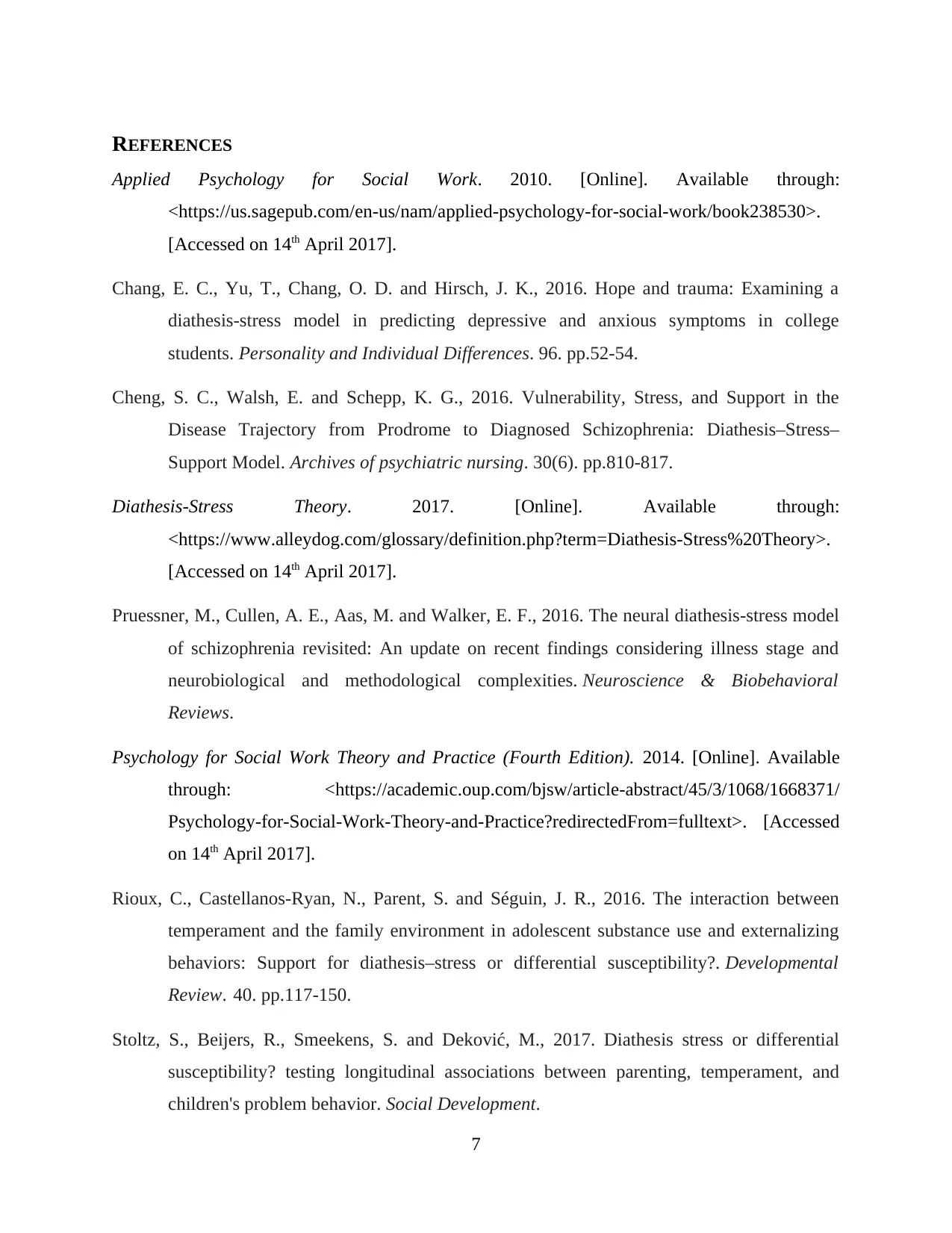
REFERENCES
Applied Psychology for Social Work. 2010. [Online]. Available through:
<https://us.sagepub.com/en-us/nam/applied-psychology-for-social-work/book238530>.
[Accessed on 14th April 2017].
Chang, E. C., Yu, T., Chang, O. D. and Hirsch, J. K., 2016. Hope and trauma: Examining a
diathesis-stress model in predicting depressive and anxious symptoms in college
students. Personality and Individual Differences. 96. pp.52-54.
Cheng, S. C., Walsh, E. and Schepp, K. G., 2016. Vulnerability, Stress, and Support in the
Disease Trajectory from Prodrome to Diagnosed Schizophrenia: Diathesis–Stress–
Support Model. Archives of psychiatric nursing. 30(6). pp.810-817.
Diathesis-Stress Theory. 2017. [Online]. Available through:
<https://www.alleydog.com/glossary/definition.php?term=Diathesis-Stress%20Theory>.
[Accessed on 14th April 2017].
Pruessner, M., Cullen, A. E., Aas, M. and Walker, E. F., 2016. The neural diathesis-stress model
of schizophrenia revisited: An update on recent findings considering illness stage and
neurobiological and methodological complexities. Neuroscience & Biobehavioral
Reviews.
Psychology for Social Work Theory and Practice (Fourth Edition). 2014. [Online]. Available
through: <https://academic.oup.com/bjsw/article-abstract/45/3/1068/1668371/
Psychology-for-Social-Work-Theory-and-Practice?redirectedFrom=fulltext>. [Accessed
on 14th April 2017].
Rioux, C., Castellanos-Ryan, N., Parent, S. and Séguin, J. R., 2016. The interaction between
temperament and the family environment in adolescent substance use and externalizing
behaviors: Support for diathesis–stress or differential susceptibility?. Developmental
Review. 40. pp.117-150.
Stoltz, S., Beijers, R., Smeekens, S. and Deković, M., 2017. Diathesis stress or differential
susceptibility? testing longitudinal associations between parenting, temperament, and
children's problem behavior. Social Development.
7
Applied Psychology for Social Work. 2010. [Online]. Available through:
<https://us.sagepub.com/en-us/nam/applied-psychology-for-social-work/book238530>.
[Accessed on 14th April 2017].
Chang, E. C., Yu, T., Chang, O. D. and Hirsch, J. K., 2016. Hope and trauma: Examining a
diathesis-stress model in predicting depressive and anxious symptoms in college
students. Personality and Individual Differences. 96. pp.52-54.
Cheng, S. C., Walsh, E. and Schepp, K. G., 2016. Vulnerability, Stress, and Support in the
Disease Trajectory from Prodrome to Diagnosed Schizophrenia: Diathesis–Stress–
Support Model. Archives of psychiatric nursing. 30(6). pp.810-817.
Diathesis-Stress Theory. 2017. [Online]. Available through:
<https://www.alleydog.com/glossary/definition.php?term=Diathesis-Stress%20Theory>.
[Accessed on 14th April 2017].
Pruessner, M., Cullen, A. E., Aas, M. and Walker, E. F., 2016. The neural diathesis-stress model
of schizophrenia revisited: An update on recent findings considering illness stage and
neurobiological and methodological complexities. Neuroscience & Biobehavioral
Reviews.
Psychology for Social Work Theory and Practice (Fourth Edition). 2014. [Online]. Available
through: <https://academic.oup.com/bjsw/article-abstract/45/3/1068/1668371/
Psychology-for-Social-Work-Theory-and-Practice?redirectedFrom=fulltext>. [Accessed
on 14th April 2017].
Rioux, C., Castellanos-Ryan, N., Parent, S. and Séguin, J. R., 2016. The interaction between
temperament and the family environment in adolescent substance use and externalizing
behaviors: Support for diathesis–stress or differential susceptibility?. Developmental
Review. 40. pp.117-150.
Stoltz, S., Beijers, R., Smeekens, S. and Deković, M., 2017. Diathesis stress or differential
susceptibility? testing longitudinal associations between parenting, temperament, and
children's problem behavior. Social Development.
7
Paraphrase This Document
Need a fresh take? Get an instant paraphrase of this document with our AI Paraphraser
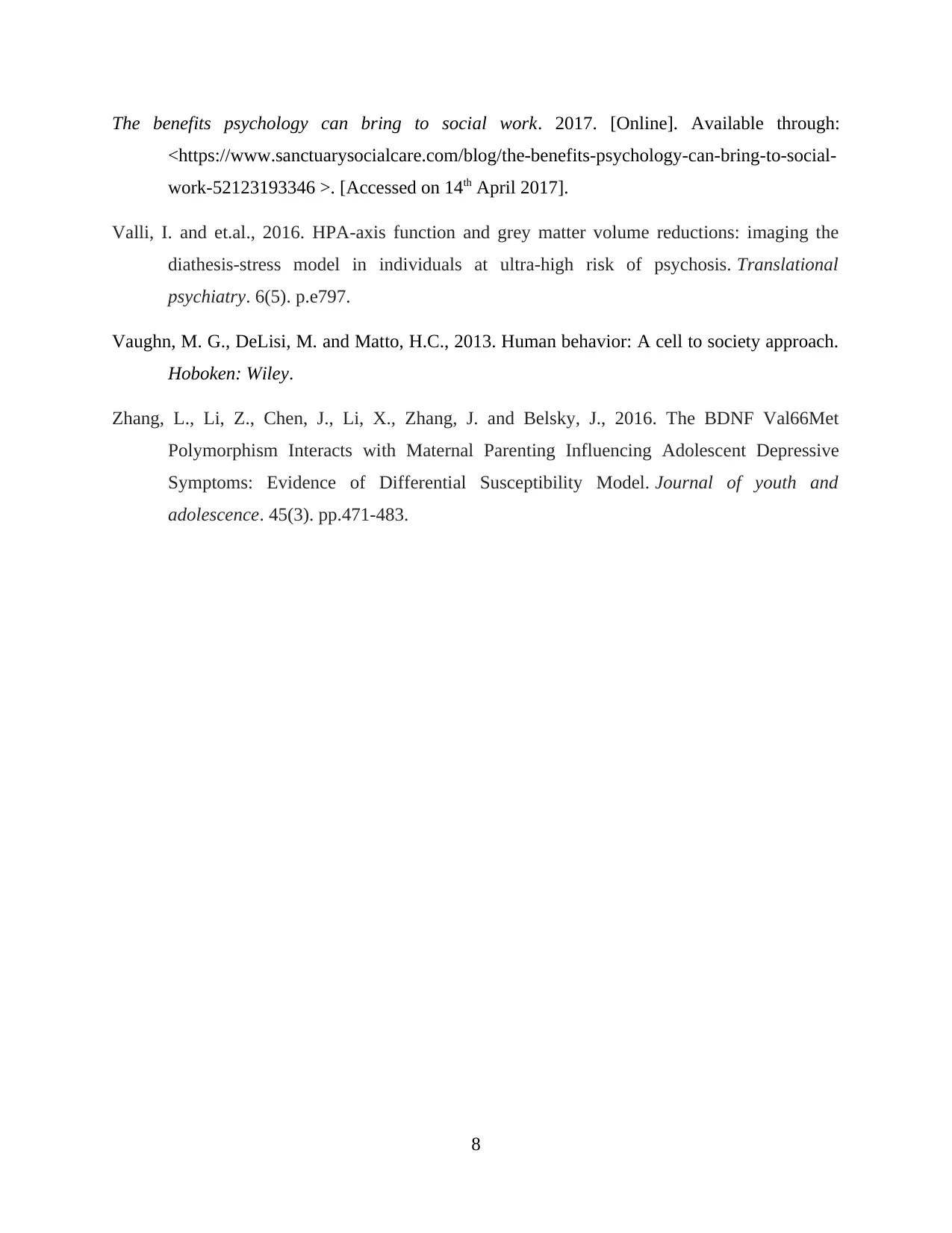
The benefits psychology can bring to social work. 2017. [Online]. Available through:
<https://www.sanctuarysocialcare.com/blog/the-benefits-psychology-can-bring-to-social-
work-52123193346 >. [Accessed on 14th April 2017].
Valli, I. and et.al., 2016. HPA-axis function and grey matter volume reductions: imaging the
diathesis-stress model in individuals at ultra-high risk of psychosis. Translational
psychiatry. 6(5). p.e797.
Vaughn, M. G., DeLisi, M. and Matto, H.C., 2013. Human behavior: A cell to society approach.
Hoboken: Wiley.
Zhang, L., Li, Z., Chen, J., Li, X., Zhang, J. and Belsky, J., 2016. The BDNF Val66Met
Polymorphism Interacts with Maternal Parenting Influencing Adolescent Depressive
Symptoms: Evidence of Differential Susceptibility Model. Journal of youth and
adolescence. 45(3). pp.471-483.
8
<https://www.sanctuarysocialcare.com/blog/the-benefits-psychology-can-bring-to-social-
work-52123193346 >. [Accessed on 14th April 2017].
Valli, I. and et.al., 2016. HPA-axis function and grey matter volume reductions: imaging the
diathesis-stress model in individuals at ultra-high risk of psychosis. Translational
psychiatry. 6(5). p.e797.
Vaughn, M. G., DeLisi, M. and Matto, H.C., 2013. Human behavior: A cell to society approach.
Hoboken: Wiley.
Zhang, L., Li, Z., Chen, J., Li, X., Zhang, J. and Belsky, J., 2016. The BDNF Val66Met
Polymorphism Interacts with Maternal Parenting Influencing Adolescent Depressive
Symptoms: Evidence of Differential Susceptibility Model. Journal of youth and
adolescence. 45(3). pp.471-483.
8
1 out of 8
Related Documents
Your All-in-One AI-Powered Toolkit for Academic Success.
+13062052269
info@desklib.com
Available 24*7 on WhatsApp / Email
![[object Object]](/_next/static/media/star-bottom.7253800d.svg)
Unlock your academic potential
Copyright © 2020–2025 A2Z Services. All Rights Reserved. Developed and managed by ZUCOL.





